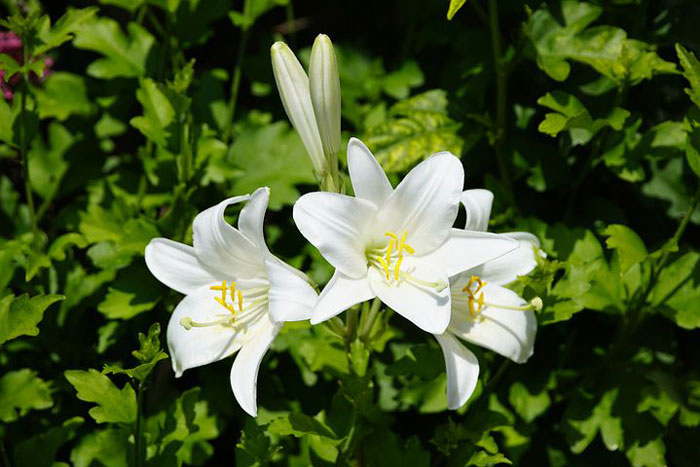1. Botanical Name: Lilium candidum
2. Common Name: Madonna Lily, Annunciation Lily, White Lily, Lilium St. Joseph's, Lilium Annunciationis
3. Description:
- Appearance: Madonna Lilies are tall, elegant plants that can reach a height of 3 to 5 feet (0.9 to 1.5 meters). They have erect, sturdy stems and produce large, pure white, trumpet-shaped flowers. The petals are often recurved, giving the flower a distinct appearance.
- Fragrance: One of the most notable features of the Madonna Lily is its strong, sweet, and captivating fragrance. The scent is often described as heavenly and has made this flower a symbol of purity and spirituality.
4. Cultural and Historical Significance:
- Religious Symbolism: The Madonna Lily has been associated with various religious and mythological stories. It is often seen as a symbol of purity and is connected to the Virgin Mary in Christian iconography. It's believed to represent the Annunciation, when the Angel Gabriel announced to Mary that she would give birth to Jesus.
- Ancient History: The Madonna Lily has been cultivated for thousands of years. It was highly prized in ancient civilizations, including those of the Mediterranean, for its beauty and scent.
5. Growing Conditions:
- Climate: Madonna Lilies prefer a temperate climate and thrive in regions with cold winters and warm, dry summers.
- Soil: Well-draining soil is essential for these lilies. They do best in slightly alkaline or neutral soil.
- Sunlight: They require full to partial sun, with at least 6 hours of sunlight per day.
- Watering: Keep the soil consistently moist but not waterlogged, especially during the growing season in spring and early summer.
6.Propagation:
- Madonna Lilies can be propagated through bulb division or by sowing seeds, although the former is more common.
7. Care and Maintenance:
- Deadhead spent blooms to encourage new flower production.
- In colder climates, protect the bulbs from freezing by applying mulch in late fall.
- Madonna Lilies may require staking to support their tall stems.
- Fertilize with a balanced, all-purpose fertilizer in the spring.
8. Pest and Disease:
- Common pests include aphids and lily beetles.
- Diseases that may affect Madonna Lilies include gray mold (Botrytis) and various fungal infections.
9. Uses:
- Ornamental: Madonna Lilies are primarily grown for their ornamental value in gardens and flower arrangements.
- Medicinal: Historically, some parts of the Madonna Lily were used in traditional medicine for various purposes, but they should be used with caution due to their toxic properties.
10. Toxicity:
- All parts of the Madonna Lily, especially the bulbs, are toxic when ingested. They contain compounds like alkaloids and should not be consumed.
Madonna Lilies are a beautiful and historically significant flower with a rich cultural heritage. They are often grown for their aesthetic appeal and symbolic meaning in various religious and cultural contexts.


:max_bytes(150000):strip_icc()/gettyimages-914296496-2000-3546d73e7b264247b3d392253dbf032a.jpg)

